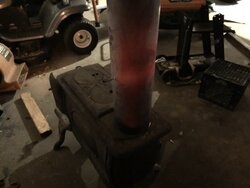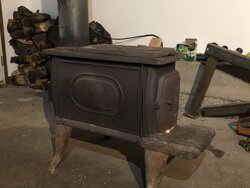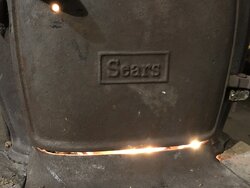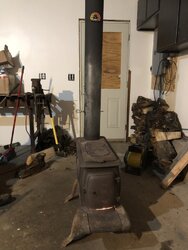was talking to my GF about buying a wood stove for the garage so she gave me money for one as an early Christmas present last week. Was looking to spend around 100-150, found a Sears top loader on CL for $150, offered 100, he said 125, he didn’t have change for 20s so I gave him $123.
Got it hooked up and fired to burn the paint off the single wall pipe, test it as well. I found it’s somewhat hard to control the heat from it and the stove pipe will glow red fairly easy. Where should I mount the thermometer on the stove pipe to monitor temp, down towards the stove or where I have it now about 3ft up?
Should there be a baffle in the stove below the 6” chimney exit so direct flames don’t go up the chimney?
Also there are a lot of small gaps around the top parts and door, should I attempt to seal up the top with some type of fire caulk so I can better control the air flow or this is just how these stoves are?
I am not looking for anything crazy or like 90% efficiency here, just want an easy to run stable stove for my garage without having to worry about it running away or dying out.
Attached pics of said stove.
Got it hooked up and fired to burn the paint off the single wall pipe, test it as well. I found it’s somewhat hard to control the heat from it and the stove pipe will glow red fairly easy. Where should I mount the thermometer on the stove pipe to monitor temp, down towards the stove or where I have it now about 3ft up?
Should there be a baffle in the stove below the 6” chimney exit so direct flames don’t go up the chimney?
Also there are a lot of small gaps around the top parts and door, should I attempt to seal up the top with some type of fire caulk so I can better control the air flow or this is just how these stoves are?
I am not looking for anything crazy or like 90% efficiency here, just want an easy to run stable stove for my garage without having to worry about it running away or dying out.
Attached pics of said stove.





